Recent Articles
Popular Makes
Body Types
2017 Smart ForTwo Cabriolet Road Test and Review
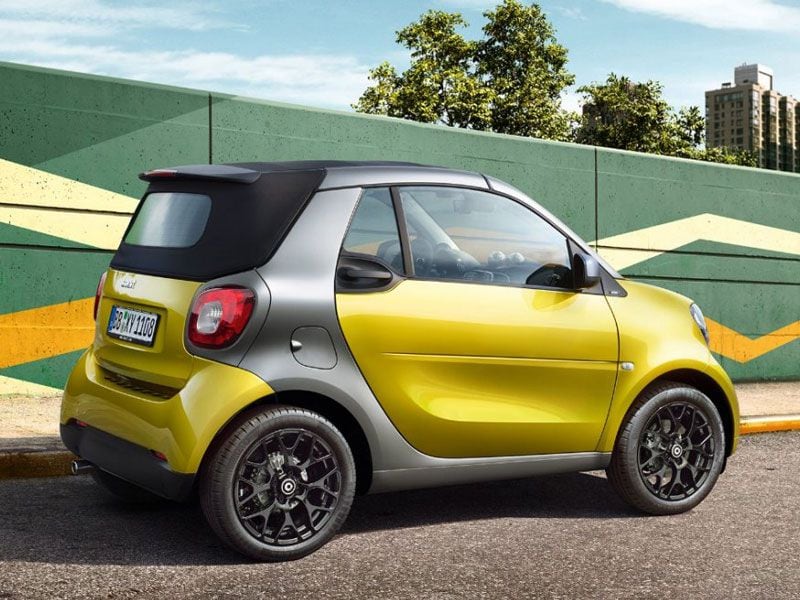
2017 smartfortwo cabriolet rear profile parked
Most Convertibles don't come cheap, but the 2017 Smart ForTwo Cabriolet comes the closest: At $19,650 (including destination charge), the Smart ForTwo is not only the least expensive convertible sold in America, it's also the only drop-top priced below $20,000. But is this a convertible you'd want to live with? Let's take it for a road test spin and find out with this review.
Room for improvement.
A couple of years ago, I mentioned to a fellow hack that I had just spent a week with the Smart ForTwo Cabriolet. He asked how I liked it, and I said that while it took a couple of days to get over its foibles, after a while, I came to like it. “You're lying,” he said, poking his finger into my chest. “No auto writer worth his salt likes the Smart ForTwo.” I suppose he had a point: While the little 2-seat Smart Car does have its rabid fans—every car does, even the worst ones—it wasn't terribly popular among critics, not so much for its small size but for the way it drove. Smart heard us loud and clear, and the all-new-for-2017 ForTwo Cabriolet—as well as the coupe, which was introduced as a 2016 model—addresses a lot of complaints about the old car.

Same package, new label.
The ForTwo Cabriolet is all new for 2017, and while the shape is different—the new one has more of a nose than the old car—the abbreviated length hasn't changed. It's still just 8 feet, 10 inches long, which is four and a half feet shorter than a Honda Fit and less than half the length of a Chevrolet Suburban. This ultra-short length allows the Smart ForTwo to pull a U-turn in a narrow alleyway with room to spare (something I highly recommend trying; it always puts a huge smile on my face). The Smart's size means it fits into half-size parking spaces with ease, which is why I once dismissed this car as a novelty. However, it just so happens that I've recently been traveling in several Smart-friendly cities, including Portland, Seattle, and New York, and I've seen smart cars tucked into the most unlikely places. Smart's CrossConnect app lets owners photograph and share the locations of these ForTwo-friendly places with other Smart drivers.
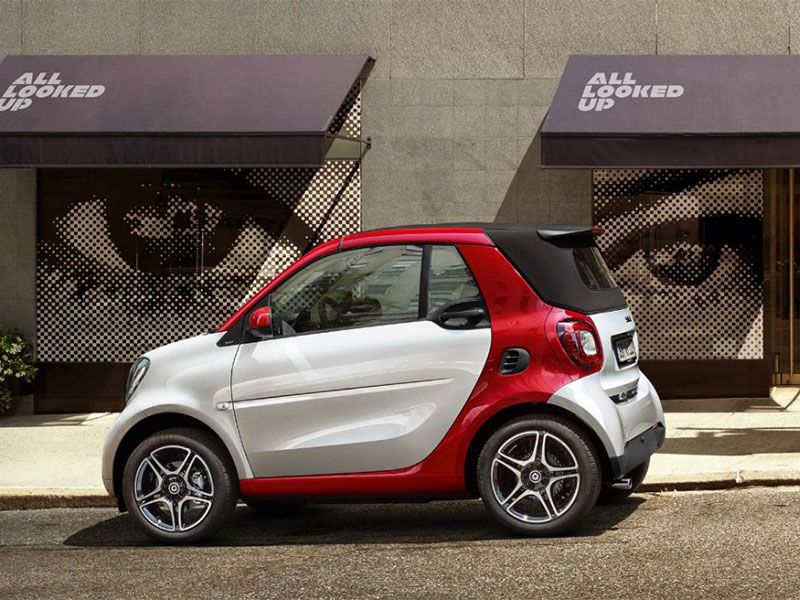
A better interior.
Inside, the ForTwo is a very different car from the previous generation. Smart has widened the car by 4.5 inches, so driver and passenger won't bump elbows quite so much. The interior design is more cohesive; the speedometer is still in a round bin behind the steering wheel. However, the stereo and climate controls look more like those in other cars. There's now room for a center arm rest between the seats (it's a $100 option), and the bottom-hinged brake pedal—which I found awkward—has been replaced by a more conventional hanging pedal. Oh, and when it comes time to start the car, the key now goes in the steering column rather than the floor—one foible I'll miss. Interior color choices include all-black, black and white, black and bright orange, and an eye-popping blue-and-white scheme best viewed with sunglasses. And speaking of colors, let's talk about the outside again: Smart offers 10 paint colors for the body (though all but black, white and red cost extra) and five colors for the “safety cage” that frames the car, plus four grille colors and two top colors.
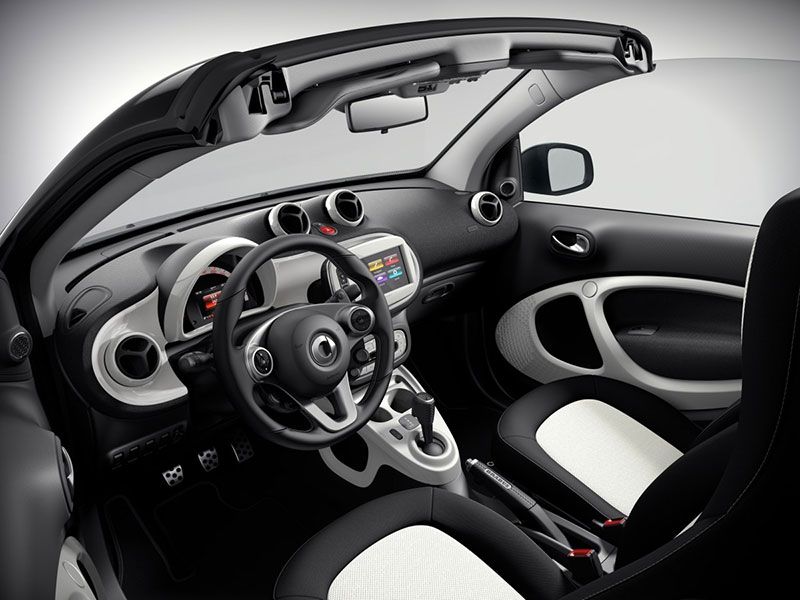
Trunk space—or lack thereof...
Despite the Smart's pert new nose, the engine is still in the back, and that means the trunk must share space with the mechanical bits. How much cargo room is on offer? Smart hadn't published the dimensions at the time of our press preview; the best I can tell you is that groceries and gym bags will fit just fine, but a medium-sized suitcase will be a bit of a struggle (best to buy soft-sided luggage). The trunk is hampered by a small opening: The rear window moves with the top (more on that in the next section), so only the bodywork opens, in the form of a flip-down trunk lid. (This isn't an uncommon sin; most convertibles have small trunks and the VW Beetle has the same problem of a small opening.) Since the engine is immediately below the cargo area, the trunk floor can get very warm when the engine is working hard—something to keep in mind if your groceries include ice cream.
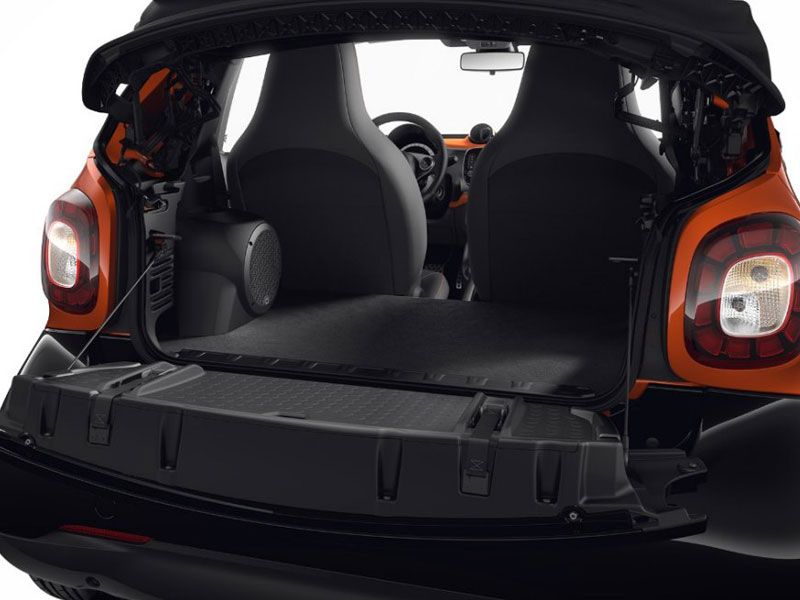
Unconventional top, but still a proper convertible.
The new ForTwo Cabriolet's convertible top uses the same basic design as the old car, with a full-width canvas roof that can operate as a giant sunroof, or slide down below roof level, taking the back window down with it. One advantage of this design is that the top can be opened and closed at any speed. Should the ForTwo Cabrio be classified as a semi-convertible like the FIAT 500C? It does have a bar that stretches the width of the car at the back corners, preserving structural integrity, but the Smart has one trick the Fiat doesn't: The roof rails that link the front and rear corners of the car can be removed and stored in the trunk lid. This eliminates the ability to raise the top at speed, but it gives the ForTwo the wide-open feel of a proper convertible, despite the fixed rear windows and back pillars.
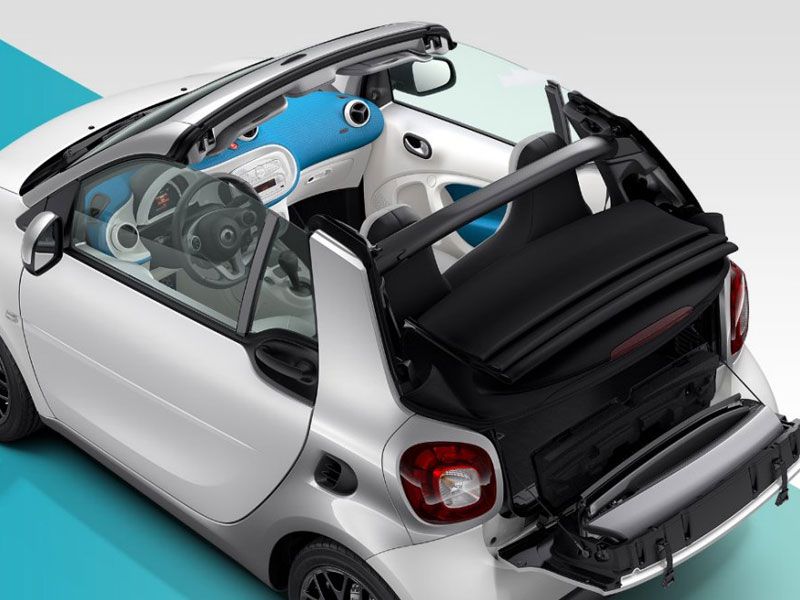
Better to drive...
The new smart fortwo Cabriolet is infinitely more pleasant to drive than the old one. Though the layout is the same—rear-engine, rear-wheel drive—all of the bits are new, including the engine, a Renault-sourced 0.9-liter turbocharged 3-cylinder. It develops 89 horsepower and 100 lb.-ft. of torque, a big improvement over the old engine (70 and 68). But the most major improvement is the new automatic transmission: The old slow-shifting 5-speed is gone, replaced by a twin-clutch automatic that shifts instantly and eliminates the herky-jerky acceleration that plagued the old ForTwo. Smart also offers a 5-speed manual, which ups the interest significantly.
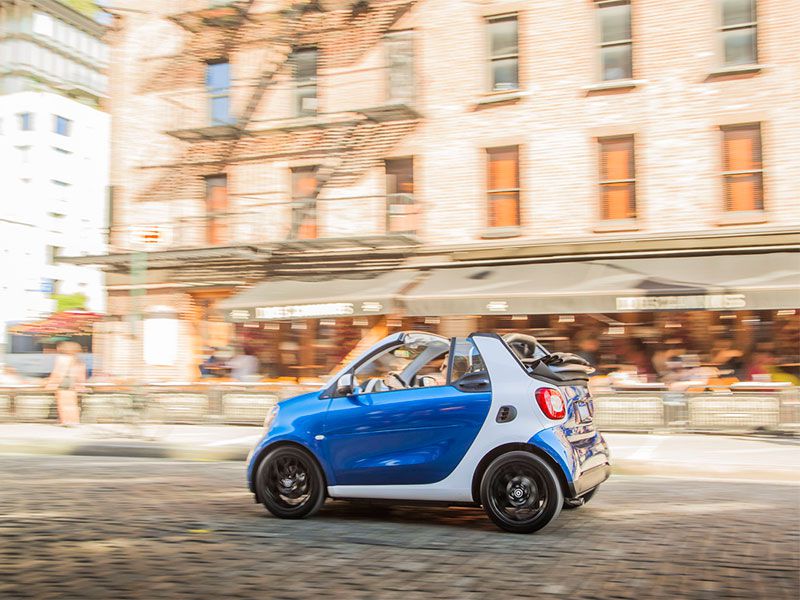
Photo by Mercedes-Benz
...but it still has issues
Unfortunately, the new Smart ForTwo is about 300 lb. heavier than the old car, nullifying much of the new engine's extra power. The new ForTwo is definitely quicker than the old one, but it's still slower than most other cars, and one must whip the engine mercilessly if one is to stay ahead of traffic. The new engine also vibrates at idle, a problem typical of 3-cylinder powerplants, and the air conditioner on my test car seemed to have trouble blowing cold air in stop-and-go traffic. (Once we were on the move, the air went frigid again.) The ride can is rough over pitted urban roads, and the ForTwo takes the bumps hard. The ride smooths out on the highway, but the Smart's short wheelbase makes for a busier-than-usual ride.
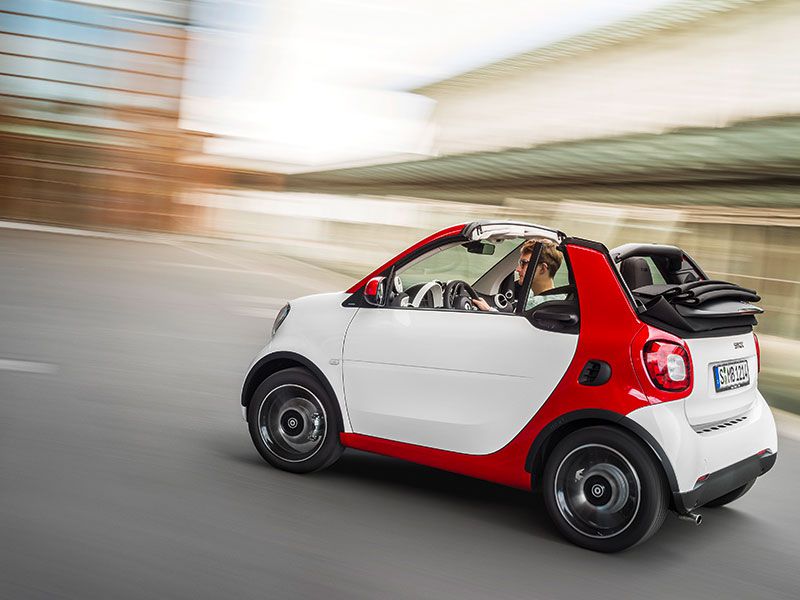
Photo by Mercedes-Benz Media
Better fuel economy, but Smart won't drink the cheap stuff.
One complaint about the old ForTwo was fuel economy: It delivered MPG in the mid-30s, on par with (or slightly worse than) than typical 4-seat compacts, and its demand for premium fuel offset much of the cost savings. The new engine still requires premium fuel—bummer—but the EPA fuel economy estimates are better: 31 MPG city/38 MPG highway with a manual transmission and 33/38 with an automatic. In my experience, real-world fuel economy from a turbocharged engine can vary significantly from those EPA numbers, and we just won't know for sure until we have some more seat time. (Our press drive took place in the traffic-choked streets of Brooklyn, New York, so we can't make a totally fair judgment.)
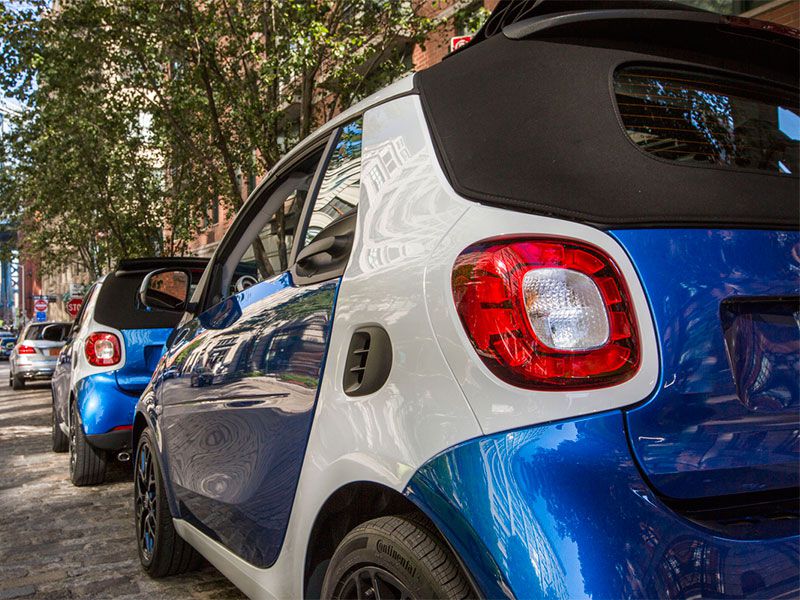
Good value compared to the competition.
Pricing for the Smart ForTwo starts at $19,650 (including a $750 destination charge), making it the only convertible sold in the US priced under $20,000. And the least expensive model (called Passion) isn't as austere as you might expect: Standard equipment includes power windows, air conditioning, Bluetooth, and cruise control. A top-of-the-line Prime model with all the options lists for $25,840. For comparison, the Mazda MX-5 Miata starts at $25,750 and the Volkswagen Beetle Cabriolet at $26,310, so the ForTwo Cabriolet is a pretty good value. The Fiat 500C starts at just $21,390, but it's not so much a convertible as it is a car with a very large sunroof.
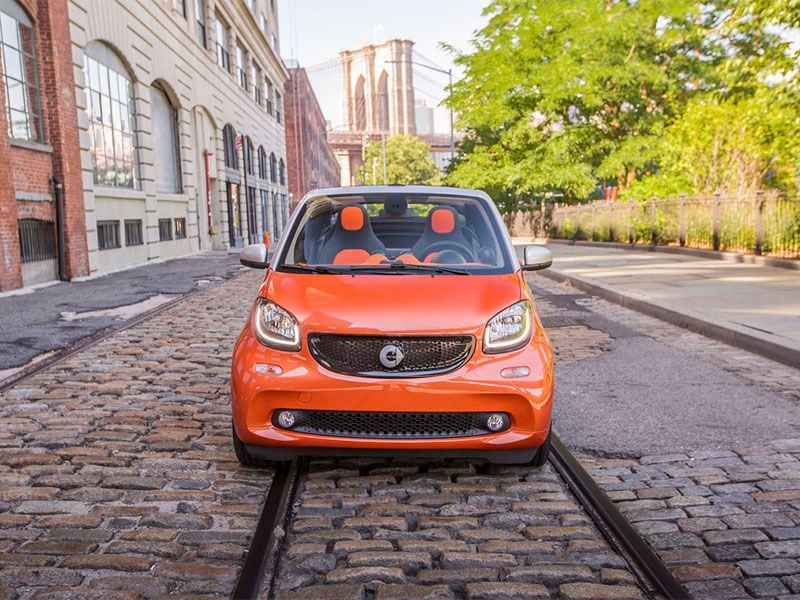
An attainable convertible.
Like the old Smart ForTwo Cabriolet, the new one has its foibles, which I've mentioned here. But what I haven't talked about is how much I enjoyed driving it. Our press preview had us driving around Brooklyn, New York, and the Smart ForTwo was the perfect way to see the city: With the top down and the roof rails removed, I had a perfect view of the urban landscape around me, and the ForTwo's small size meant it could squeeze through the gaps in traffic. I can think of few better ways to see the city (besides on foot). I imagine the ForTwo would make suburban jaunts every bit as pleasant, and while long distance trips might not be for the faint of heart, the Smart should be just fine so long as you pack light. I'm of the opinion that everyone should own a convertible at least once, and with its low base price and cheeky personality, the Smart ForTwo is a great way to make that dream come true.
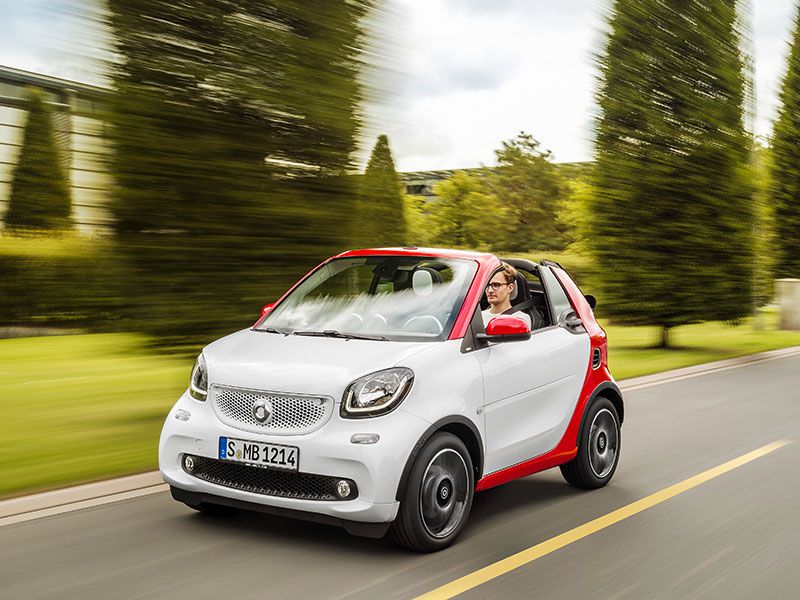
Photo by Mercedes-Benz